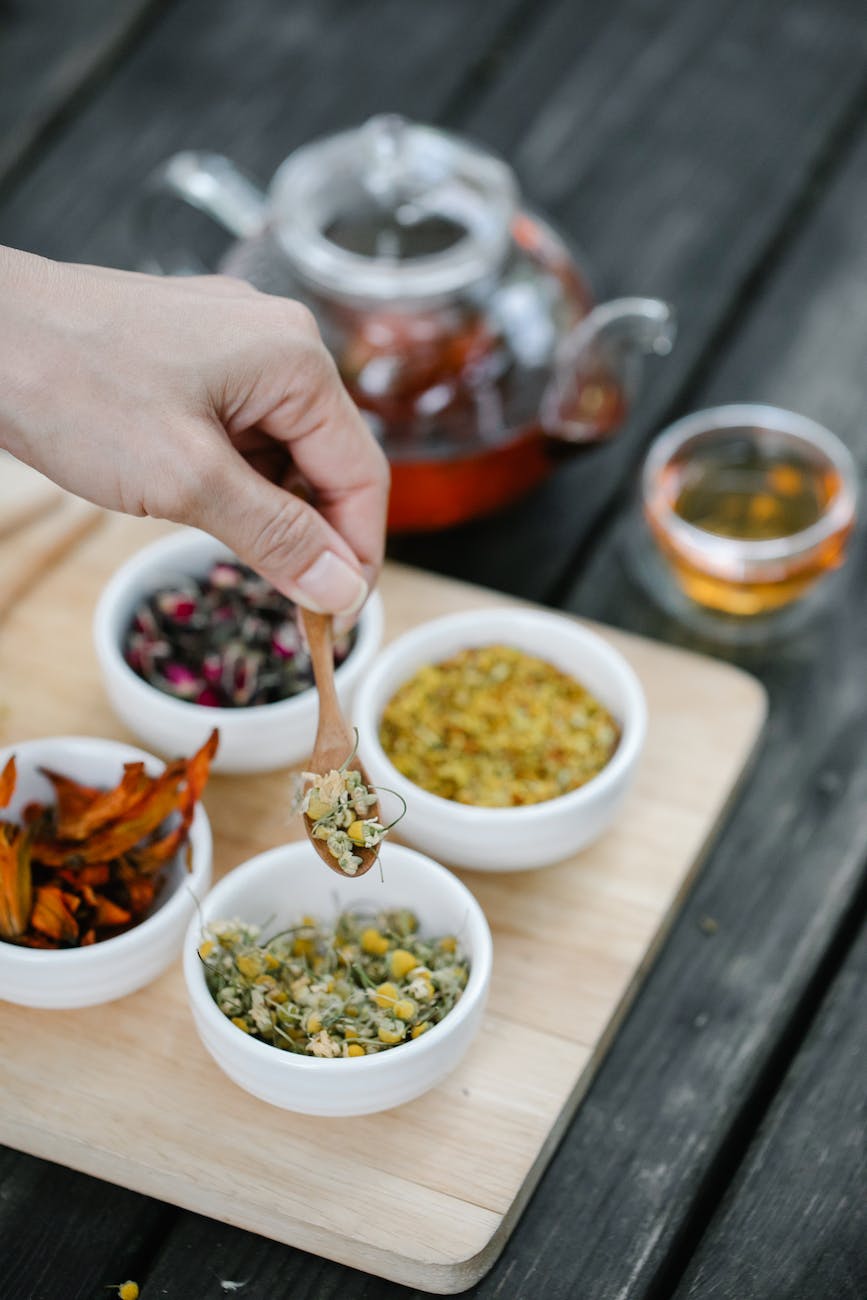
Good morning, gentle Cancer! As a water sign ruled by the Moon, you possess a deep emotional sensitivity and a nurturing soul. To cultivate inner balance and enhance your connection with your intuitive nature, let’s embark on a journey through the world of Ayurveda and discover the perfect herbal infusions tailored specifically for you. Get ready to infuse your mornings with nourishment and embrace the harmonizing power of these Cancer-inspired blends. 🌿🌙
🍃 Cancer, known for their compassionate spirit and strong intuition, can greatly benefit from herbal infusions that promote emotional well-being, nourish the soul, and create a sense of inner harmony. These nurturing elixirs not only provide a gentle start to your day but also help you align with your natural rhythms and embrace the nurturing qualities that define you. So, let’s explore the nourishing and soulful world of Cancer-infused herbal infusions and experience the magic they have to offer! ✨🌊
In Ayurveda, the ancient system of holistic healing, herbs and spices are used to balance the doshas (energies) within us. For Cancer, whose dominant element is water and ruling planet is the Moon, incorporating herbs and spices that have calming, soothing, and nurturing properties can help support their emotional well-being and enhance their connection with their inner selves.
🌿 Let’s take a closer look at the herbs and spices that make these Cancer-infused herbal infusions truly magical:
🦀 Chamomile: Chamomile is a gentle herb renowned for its calming effects on both the body and mind. It helps alleviate stress, anxiety, and promotes a sense of inner peace. Sipping on a warm cup of chamomile-infused tea in the morning can be the perfect way to start your day with serenity and a renewed sense of balance. Allow the gentle and comforting nature of chamomile to wash away tension and promote a state of calmness within. Let the soothing embrace of chamomile nurture your soul and create a harmonious start to your day.
🌊 Lemon Verbena: Lemon verbena is an herb that embodies the refreshing and invigorating qualities of water. It awakens the senses, uplifts the spirit, and promotes clarity and focus. Incorporating lemon verbena into your morning routine can help you start your day with a sense of rejuvenation and renewed energy. Let the crisp and citrusy flavors of lemon verbena enliven your senses, revitalizing your spirit and aligning you with the natural flow of the day.
🌿 Lavender: Lavender, with its delicate aroma and soothing properties, is the epitome of relaxation and tranquility. It calms the mind, eases tension, and promotes restful sleep. For Cancer, who values emotional well-being and nurturing self-care, incorporating lavender into your morning routine can set the tone for a peaceful and harmonious day. Allow the gentle and soothing essence of lavender to envelop your senses, bringing a sense of serenity and balance to your being.
🍃 Nettle: Nettle is a nourishing herb that supports overall well-being and promotes a sense of vitality. It is rich in vitamins, minerals, and antioxidants, providing nourishment and support for the body and mind. Sipping on a nettle-infused blend in the morning can provide you with a gentle boost of energy and nourishment, helping you start your day on a nourishing note. Let the nurturing qualities of nettle replenish your body and invigorate your spirit, empowering you to navigate the day with grace and vitality.
🌱 Rosemary: Rosemary is an herb that symbolizes remembrance and clarity. Its uplifting aroma and invigorating properties help enhance focus, memory, and mental clarity. Incorporating rosemary into your morning rituals can help stimulate your mind, promote mental acuity, and awaken your intuitive abilities. Let the energizing and clarifying essence of rosemary guide you towards a day filled with clarity, intention, and emotional balance.
Now that we’ve explored the magical properties of these herbs, it’s time to dive into the nourishing recipes that will infuse your mornings with balance and nourishment. Get ready to elevate your morning routine with these delightful Cancer-infused herbal infusions! 🌿🍵
🌟 1️⃣ Tranquil Chamomile: Immerse yourself in a moment of tranquility with this chamomile-infused infusion. 🦀🌼 Boil water and pour it over a chamomile tea bag or a teaspoon of dried chamomile flowers in a cup or teapot. Allow it to steep for about 5-7 minutes, releasing the calming properties and gentle aroma of chamomile. As you sip on this soothing elixir, feel a wave of calmness wash over you, nurturing your emotions and creating a sense of inner harmony. Let the gentle embrace of chamomile restore your emotional balance and bring a soothing start to your day.
🌟 2️⃣ Refreshing Lemon Verbena: Embrace the refreshing energy of water with this invigorating lemon verbena infusion. 🌊🌿 Boil water and add a few lemon verbena leaves or a lemon verbena tea bag to a cup or teapot. Allow it to steep for 5-7 minutes, releasing the vibrant citrusy flavors and revitalizing properties of lemon verbena. As you indulge in this energizing elixir, feel your senses awaken and your spirit rejuvenate. Let the crisp and uplifting nature of lemon verbena restore your vitality and align you with the gentle rhythm of the day.
🌟 3️⃣ Serene Lavender Bliss: Experience a moment of serenity and inner balance with this lavender-infused blend. 🌿🌸 Boil water and add a handful of fresh lavender buds or a lavender tea bag to a cup or teapot. Allow it to steep for 5-7 minutes, releasing the calming aroma and soothing properties of lavender. As you sip on this gentle elixir, feel the tension melt away, replaced by a deep sense of tranquility and emotional well-being. Let the nurturing essence of lavender envelop your soul and create a harmonious start to your day.
🌟 4️⃣ Nourishing Nettle Delight: Nourish your body and soul with this revitalizing nettle infusion. 🍃✨ Boil water and add a handful of nettle leaves or a nettle tea bag to a cup or teapot. Allow it to steep for 5-7 minutes, allowing the nourishing properties of nettle to infuse the water. As you savor each sip, feel a gentle wave of vitality and nourishment embrace you, replenishing your body and revitalizing your spirit. Let the nurturing qualities of nettle support your overall well-being, nurturing your inner self and providing a foundation of balance.
🌟 5️⃣ Intuitive Rosemary Awakening: Awaken your intuition and clarity with this invigorating rosemary blend. 🌱🌿 Boil water and add a sprig of fresh rosemary or a teaspoon of dried rosemary to a cup or teapot. Allow it to steep for 5-7 minutes, releasing the uplifting aroma and clarifying properties of rosemary. As you sip on this revitalizing elixir, feel your mind sharpen, your intuition deepen, and your emotional balance restore. Let the clarifying and intuitive energy of rosemary guide you through a day filled with clarity and emotional equilibrium.
✨🌄 Embrace the nourishment and balance of the morning, dear Cancer, and let these carefully curated herbal infusions become a part of your daily ritual. Allow the nurturing and harmonizing qualities of chamomile, lemon verbena, lavender, nettle, and rosemary to support your emotional well-being, enhance your intuition, and create a sense of inner balance. Stay tuned for more Zodiac-inspired blends and rituals to elevate your daily life with a touch of divine nourishment! 🌿🦀










